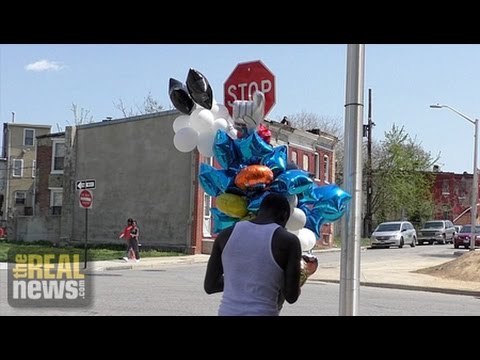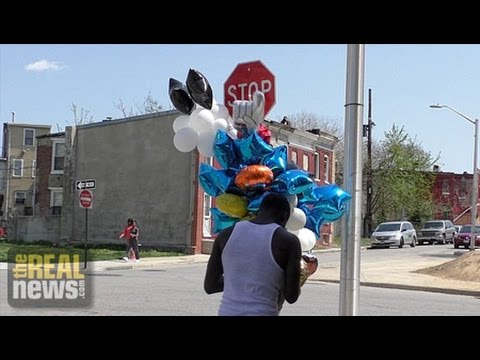With the city on edge after the death of Freddie Gray in police custody, TRNN Executive Producer Eddie Conway returned to Gilmor Homes, where Gray was arrested. There he spoke to residents to document what they witnessed, the deplorable conditions of public housing, and how aggressive policing dominated their lives.
Producers: Eddie Conway and Stephen Janis
Voiceover/Script: Stephen Janis
Photography: Cameron Granadino
Story Transcript
STEPHEN JANIS, INVESTIGATIVE REPORTER, TRNN: It’s a growing memorial, constructed from the remnants of a man’s life and death. A man who has come to symbolize one neighborhood’s pain and a city’s frustration. Residents of Gilmor Homes, trying to make something meaningful out of the brief life of Freddie Gray and his death while in police custody. This is where Gray was initially detained, and where he started what would be a slow and painful procession towards death in the back of a police paddy wagon. And while police continue to stonewall on the details relating to just exactly how Gray’s neck was severed from his spine, his community has begun the process of bearing witness to the crosscurrents of heavy-handed policing and neglect from City Hall they believe are at the root of his death that has rocked not just the community, but transfixed the nation. GILMOR HOMES RESIDENT: And it’s not okay for you to beat our young men like they, they slaves. You slaughtering them. That’s not okay to do that. JANIS: Gray died a week after he was arrested. Police say they have no evidence of use of force. Six officers have been suspended, and the Justice Department has joined the investigation. But witnesses from his community say police are not telling the truth. WITNESS: The paddy wagon was right there. They took the young man out, beat him some more. JANIS: Real News Network correspondent Eddie Conway spoke to the people who were there. One woman described how she saw firsthand what she believes were actions by police that contributed to Gray’s death. WITNESS: The man wasn’t responding. They took him by his pants and he was dragged. And I asked them to call the ambulance. They told me to mind my business. I told them it is my business. JANIS: Another, a blind resident, said he heard Gray pleading for help which never came. WITNESS: Now, they must have thrown him down. He was hollering, come on, you’re hurting my back. [Inaud.] be on my back. You’re hurting my neck. JANIS: The Gilmor Homes Project where Gray grew up in West Baltimore bears the scars of neglect. A dilapidated basketball court has sat broken for years, the housing which surrounds it falling into disrepair. But the decay of the physical infrastructure has not stopped the city from flooding the neighborhood with police, a constant flow of law enforcement that residents told Conway made it impossible to even stand outside in a place where they grew up. GILMOR HOMES RESIDENT: They drive past when we right here, they’re making us move even if we live right here or not. Go inside, you can’t stand here. GILMOR HOMES RESIDENT: They won’t let us sit nowhere. They’ll tell us move, we gotta go here, we gotta move off there, we’re not doing nothing. JANIS: In fact, Gilmor Homes is one of the most heavily policed and incarcerated neighborhoods in the city. The Justice Policy Institute estimates the state spends $17 million annually just to lock up residents of the West Baltimore community, which is why residents say the cycle of neglect and punishment only makes things worse. GILMOR HOMES RESIDENT: They had beat my friend up real bad, and they handcuffed me just because I was saying, why y’all beating him like–why y’all beating him like that? They put handcuffs on me. GILMOR HOMES RESIDENT: [Inaud.] expect us to go do when we come home. We on parole and all that shit. We going to go directly to jail. They check ten years back, eleven years back and all that dumb shit. They’re expecting us to get a [inaud.] JANIS: And why the death of Freddie Gray is symbolic in a city where policing and poverty seem inextricably linked. Reporting for The Real News Network, Stephen Janis in Baltimore.
End
DISCLAIMER: Please note that transcripts for The Real News Network are typed from a recording of the program. TRNN cannot guarantee their complete accuracy.






